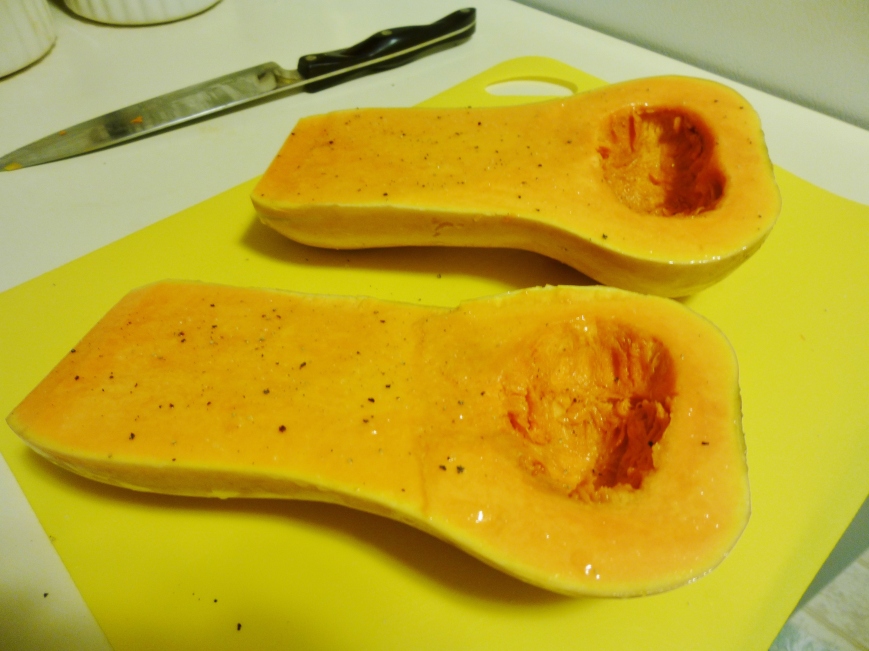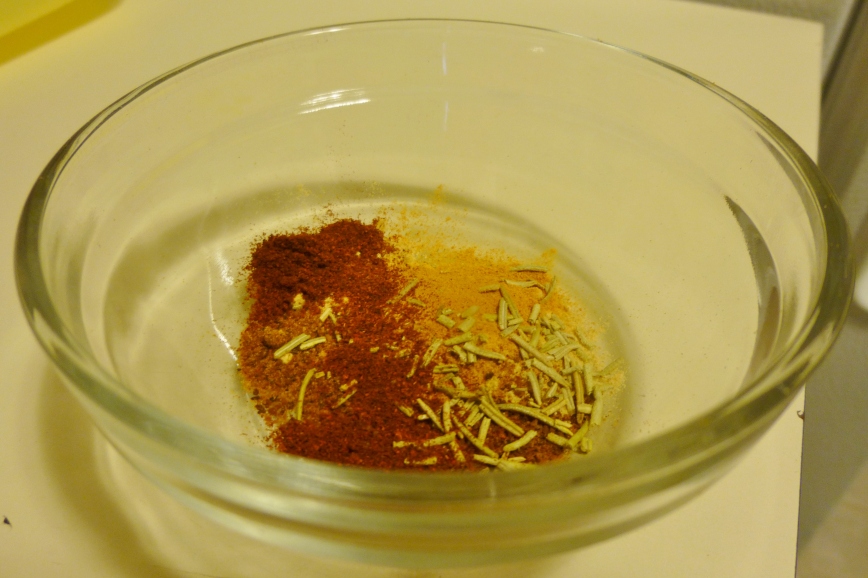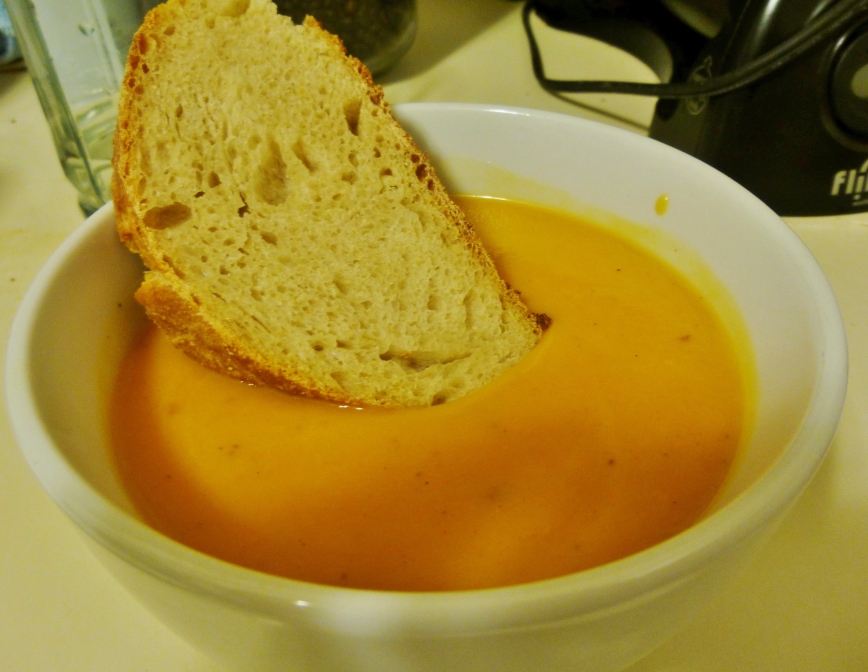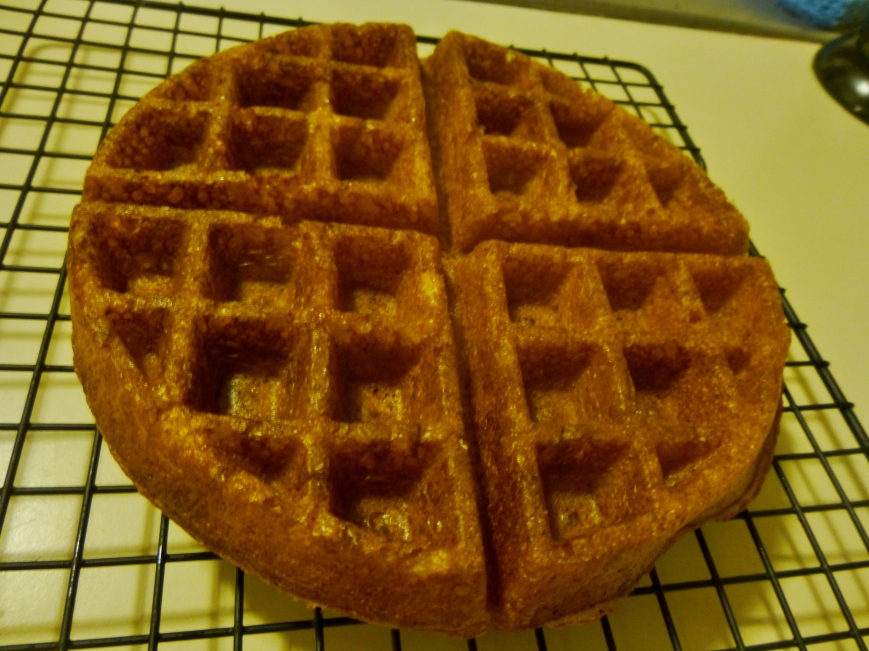Edit: pictures now present, long-winded narrative remains.
Fall approaches, and the warm and cozy caramel flavors of fall food are already starting to tempt our taste buds. Well, I like them all year ’round, but I also sing Christmas songs all year round, so I’m always in a state of seasonal dysfunction.
In any case, I’ve had people ask about my method of dealing with butternut-squash soup. It’s such an enjoyable soup, but it’s also a lot of work. I decided after I acquired a butternut squash last winter that I had no interest in peeling the large, hard fruit, then cutting it up and boiling it, all the while fussing with onions, garlic, spices, and the whole motley crew of necessary flavor supports. I then realized that roasting would enhance the delicious flavor of the squash far more than boiling would, and would be much easier and more hands-off than cutting the whole thing up. So I started looking for recipes, and liked what I saw. I went off to work thinking happily about the soup I would make.
But before I arrived home I realized something even more wonderful: why did only the squash have to be roasted? Why couldn’t I throw the onion and garlic in there as well? This would reduce the labor significantly, and again, because roasting would bring out a dark, earthy, caramelized flavor in the other vegetables as well, it would be especially wonderful.
Reader, it was true. Sometimes easier is better. It is so with Easy Mac and it is so with this. The same warning goes with this as goes with most of my recipes: I cook iteratively and intuitively, so the spice and liquid amounts are mere estimates. Be conservative with each at first, and add more if you need to.
ALL ROASTED EVERYTHING BUTTERNUT SQUASH SOUP (can be made vegan!)
(Makes four-ish good-sized servings? Maybe more? I don’t know, I eat a lot)
Section 1, the ingredients that get roasted
- 1 large or 2 to 3 adorably small butternut squash
- 1 onion, size dependent on how much you love onion
- 2 or 3 cloves of garlic (peeled)
- Salt, pepper, and neutral oil such as canola oil
Section 2, the other stuff
- 1 tablespoon butter or oil
- Spices: start with a good pinch each of paprika, turmeric, ginger, nutmeg, dried rosemary, sage (if you like), and pepper, and keep them handy to add more later. Shoot, throw in some cumin too, if you want. Don’t be afraid of the nutmeg, though–it really enhances the creaminess of the soup in a wonderful way
- 2.5-3 cups of chicken or vegetable broth, or other not overly assertive broth–low sodium if possible
- Water as needed (see procedures)
- About 1/3 cup cream, evaporated milk, or coconut milk (start with this and add more if you think it’s needed)
Procedure
Turn your oven to 400 degrees F. While it heats, rinse off your squash, cut off its stem, and slice it lengthwise. Scoop out the seeds and fibers (though you don’t have to be obsessive about the fibers, since it’s going to be blended anyway). If you want, reserve the seeds and toast them, using them as a garnish. Rub the tops with oil and sprinkle reasonably generously with salt and pepper. My squash this last time was a little underripe, leading to a sort of starchy, fibrous soup. Be sure to get a ripe squash, don’t do as I did.
Put on a cookie sheet, jelly roll pan, or other such large, flat pan, and pop it into the oven.
20 minutes after the squash starts cooking, peel and cut your onion. If it’s small, cut it into fourths; if large, into eighths; if somewhere in between, use your mathematical judgment. It’s not really that big of a deal. Toss the onion and garlic with some more oil (enough to coat them lightly) and sprinkle some salt and pepper on them too. Open your oven door and just put them in the same pan as the squash. Give them a stir in about 20 minutes.
At any point in the next 40 minutes after you’ve put the onions and garlic in (so you can see, the total cooking time for the squash is one hour, or until fork tender; the onions and garlic should, by this time, be soft everywhere and dark brown in spots but not, you know, burned), get a deep pot and put it on the stove. Turn the heat to medium. Put the butter in, and when it’s melted and starting to foam, put in your spice mélange.
This is called “blooming” the spices and it’s very common in Indian cooking. The spices will have a far more delightful and intense flavor than if you just threw them into wet soup. You can definitely add more to the completed soup to correct the spice level, but starting with at least a perceptible base will really help. Anyway, bloom them for about a minute, then pour in your broth. Give it a stir and turn the heat down to medium low if the vegetables are ready, or very low (plus cover your pot) if you still have to wait awhile.
Now get your roasted vegetables out. Scoop the squash out of its skin and dump it into the pot, along with the delicious roasted onions and garlic. Be sure to have turned the heat back up to medium low if you had it on low. Stir all this and let it incorporate for a minute, give it a taste, and adjust as needed. Now (carefully!) transfer to a blender and blend on a low setting (too high and it will get thin and watery) until it’s homogeneous, removing the pot from the burner but keeping the heat on. Transfer back to the pot and put it back on the burner, taste and adjust seasoning again, and add water if it’s too thick for your liking. Finally, stir in your cream and serve! You will love it, I assure you. Please remember to turn the burner and oven off once you’re finished, though. Only you can prevent house fires.
While you’re at it, why not serve with some home-made whole grain sourdough bread? That wouldn’t hurt, right? (Pay no attention to the dirty counter. It’s a figment of your imagination.)



